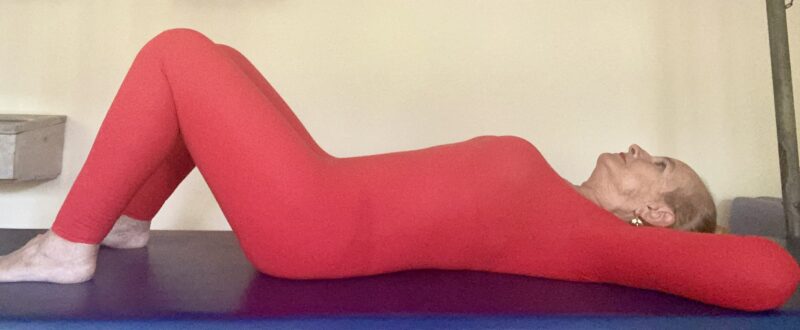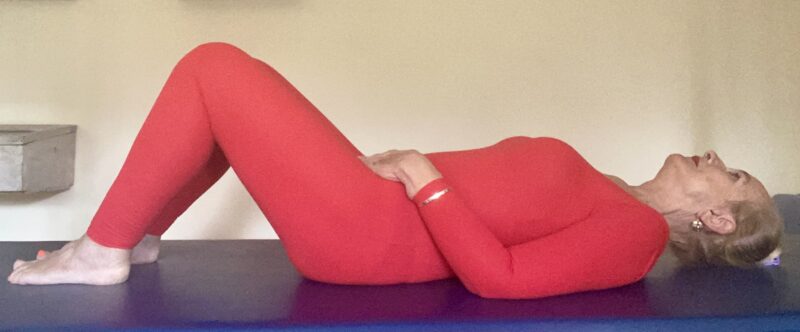Christmas is coming and many of us are thinking about our figures. How to get into shape before we start eating all those delicious treats? It’s a matter of our general health as well as just the approaching festive season, and wish to look great, and be able to maybe eat a little bit more. Keeping our abdominal muscles in tone supports our lower back, as well as keeping our organs vital and healthy.
Pilates devised a system which involve many abdominal exercises. As a Pilates teacher, I encounter two problems.
The first problem is that many of my students experience pain and tension in the neck when they attempt to do the classic exercises, such the classic five for the abdominals, the Double Leg Stretch, the Single Leg Stretch, the Single Straight leg Stretch, the Double Straight Leg Stretch and the Criss Cross.
I have found using pillows as support, not very effective, in addressing this problem because people still tense their necks..
A very careful preparatory exercise is helpful. And then, utilising that preparation in the classic exercises will prevent people suffering from neck pain.
The second issue is for people that have Kyphosis. A lot of the exercises in the Pilates system involve rounding the back, or the first spinal succession. I will write another blog about how to strengthen the abdominals with the second spinal succession, avoiding an over emphasis on rounding the back, and therefore creating an imbalance, in using the first position of the spine too often, for these students.
Careful abdominal preparation which can be applied to many exercises in the Pilates repertoire.
ABDOMINAL PREPARATION
RECOMMENDED.
This exercise is suitable for all and highly recommended for people with back problems. Pregnant ladies can do this exercise whilst they are still comfortable on their backs.
REPETITIONS.
x 5 – 10
STARTING POSITION.
Lie on your back with the knees bent and the feet hip width apart. It is important to think of the spine as relating to the axis, or middle line of the body, and the bones of the back of the pelvis, and the legs as belonging to the sides of the body. Make sure of the leg alignment. See my blog https://jennycolebourne.com/good-leg-alignment-is-essential-for-everyone/ It is very important.. Have the heels as comfortably close to the buttocks as possible. The fingers are laced, the elbows bent and open.

The hands cup the back of the skull or the occiput. The occiput is a magical bone that can connect us with all of the spine, right down the tail. The pads of the thumbs access the base of the skull on either side of the spine. it is essential to maintain the natural curve of the neck. Access the fascia through the skin. Pull gently when is the thumbs to create more space in the neck without destroying the natural curve. The arms are like an upside down triangle. The base of the triangle is the line between the elbows and the apex, a vertebra somewhere on the thoracic spine probably T7. Gently lengthen between the elbows which are open and on the floor and make sure the shoulder joints are completely soft. and the shoulders are down away from the ears. Surrender the weight of the upper back completely to gravity.

BREATH IN.
Use the occiput as a boney handle and gently pull up towards the crown of the head. the natural curve of the cervical spine remains. The balance between the front and the back of the neck is maintained. You simply create more space between the vertebrae of the neck.
BREATH OUT.

Connect the muscles of the pelvic floor, hollow the abdomen, drop the lumbar spine to the floor. Utilise the out breath, it is natural for the belly to drop towards the inside edge of the spine when we breathe out. Take a advantage of that. Make sure the hip joints are soft. The triangle of the pelvis. The pubic bones and the front of the iliac crests are parallel to the floor. It is good to check you are not accidentally bringing the pubic bone more up towards the ceiling or “tucking”at any point during the exercise. Because you energise the muscles of the pelvic floor, hollow the abdomen and drop the lumbar spine, sacrum and coccyx to gravity, the upper body becomes light, and the head and the upper back roll up effortlessly. The elbows can come, gently, a little more together. For a detailed analysis of moving into the first spinal succession or a rounded back read my blog https://jennycolebourne.com/jerome-andrews-pilates-the-first-spinal-succession. You will find more details about spinal succession in my video https://youtu.be/1yxwft5ERJI?si=NHZeHkoBQI_hII6j
BREATH IN.
Stay in this position. The in breath will expand the back of the rib cage, and the back of the lungs and help you deepen the curve. The eyes gaze at the abdomen just above the pubic bone. The front to the body is soft. The breast bone gently folds in. Shoulders relaxed. You deepen the curve.
BREATH OUT.
Move back down vertebra by vertebra, lengthening and creating more space between the vertebra, each segment, as you go. As you place the head back down visualise a golden thread, starting below the tip of the coccyx (tail) traveling through the spine and continuing back, above the crown of the head. The natural curves of the spine wave along this axis. Open the elbows and surrender the weight of the upper back to the floor. It is important to relax all of the weight of the back of the body to gravity. For a detailed explanation of the second spinal succession or neutral spine look at my blog https://jennycolebourne.com/second-spinal-succession-and-position-for-refined-pilates-and-yoga/
NOTES.
This exercise can be done with the feet up on a ball or a box. Having the feet higher helps to drop the lower back even more to gravity. The legs are more relaxed and so it is easier to keep the hip joints released.
Apply the first movement and position, to all of the five exercises that I mentioned. Having this additional support for the head and the neck, at least in the beginning, it could be the difference between people doing the series of exercises or not.
Happy necks. Happy exercising.

Checking the alignment of my pelvis before starting. The pubic bones and the front edges of my iliac crests are parallel to the floor. Hip joints relaxed. Feet dropped to gravity.

